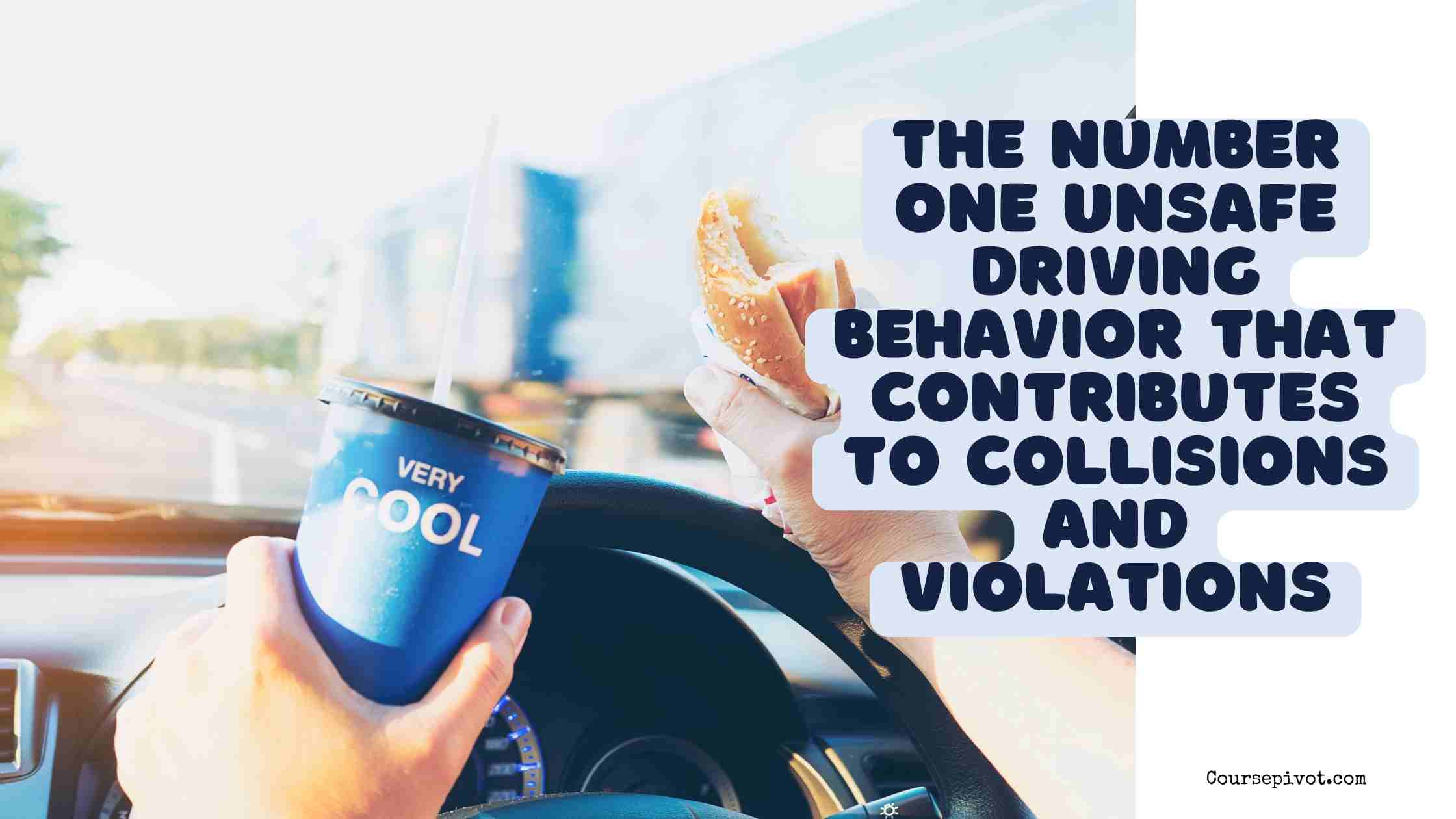
The Number One Unsafe Driving Behavior Contributing to Collisions and Violations
Ever wondered why car crashes and traffic tickets seem so common, despite all the rules and warnings? The question What is the number one unsafe driving behavior that contributes to collisions and violations? gets to the core of a critical issue on our roads. With over 6 million crashes in the U.S. alone each year, per NHTSA 2023 data, identifying the top culprit can save lives and reduce chaos. This blog dives into why distracted driving, particularly texting or phone use, stands out as the leading unsafe behavior, exploring its impact, evidence, and why it edges out other risky habits like speeding or tailgating.
Table of Contents
Distracted driving’s rise, fueled by smartphones, has made it a global concern, with 80% of drivers admitting to distractions, per AAA surveys. By examining crash statistics, psychological factors, and real-world examples, this exploration aims to clarify why it’s the top threat and how to address it. Let’s hit the road to uncover the facts.
What Is Unsafe Driving Behavior?
Unsafe driving behaviors are actions that increase the risk of collisions, injuries, or traffic violations, deviating from safe practices like staying focused or obeying laws. Common culprits include:
- Distracted Driving: Activities like texting, eating, or adjusting controls, diverting attention.
- Speeding: Driving too fast for conditions or limits, reducing reaction time.
- Tailgating: Following too closely, limiting stopping distance.
- Drunk Driving: Operating a vehicle with a blood alcohol concentration (BAC) of 0.08 or higher.
- Ignoring Signals: Violating traffic signs or lights, disrupting flow.
These behaviors contribute to 90% of crashes, per NHTSA, but one stands out for its prevalence and impact.
Why Distracted Driving Is the Number One Unsafe Behavior
Distracted driving, defined as any activity diverting attention from the road, is the leading unsafe driving behavior contributing to collisions and violations. Texting or phone use is the most dangerous distraction, with 3,308 deaths and 400,000 injuries in U.S. crashes in 2022, per NHTSA. Here’s why it tops the list:
Prevalence and Frequency
- Widespread Use: 80% of drivers use phones while driving, per AAA 2023 surveys, with 10% of teen drivers distracted in fatal crashes, per NHTSA.
- Texting Impact: Reading or sending a text takes eyes off the road for 5 seconds—at 55 mph, that’s like driving a football field blind, per NHTSA.
- Broad Scope: Distractions include eating, talking, or adjusting GPS, but phone use dominates, involved in 20% of crashes, per safety studies.
Unlike speeding (29% of fatal crashes) or tailgating (36% of rear-end collisions among young drivers), distracted driving’s constant temptation via smartphones makes it more frequent, affecting 93% of lead-vehicle crashes, per ScienceDirect.
Severe Impact on Reaction Time
- Cognitive Load: Texting splits focus, reducing reaction time by 35%, worse than drunk driving at 0.08 BAC, per NHTSA tests.
- Multi-Task Failure: Humans process only one visual task at a time, with 50% of drivers missing hazards while distracted, per psychology data.
- Crash Severity: Distractions delay braking, increasing 40% of rear-end or intersection crashes, per AAA.
Speeding reduces stopping distance, but distraction often prevents drivers from noticing the need to stop, making it deadlier in urban settings, where 50% of crashes occur, per FHWA.
Legal and Violation Trends
- Rising Tickets: Distracted driving citations rose 20% from 2019–2023, per state DMV data, outpacing speeding fines in 30% of U.S. states.
- Legislation Focus: 48 states ban texting while driving, with 70% stricter penalties than speeding, per IIHS 2023, reflecting its priority.
- Crash Accountability: 25% of police-reported crashes cite distraction, higher than tailgating (15%) or speeding (10%), per NHTSA.
Violations for phone use are easier to enforce with visible evidence, unlike subjective tailgating, amplifying distraction’s legal impact.
Comparing to Other Behaviors
While speeding (12,151 deaths in 2022) and drunk driving (13,524 deaths) are deadly, distracted driving’s broader reach makes it the top concern.
- Speeding: Involved in 29% of fatal crashes, but less frequent in daily urban driving, per NHTSA.
- Tailgating: Causes 36% of rear-end crashes among young drivers, but less universal than phone use, per AAA.
- Drunk Driving: High fatality rate (40% in New Mexico crashes), but only 1% of drivers are impaired at any time, per NHTSA.
- Ignoring Signals: Contributes to 20% of intersection crashes, but less pervasive than distractions, per FHWA.
Distracted driving’s constant risk, especially among 15–19-year-olds, and its role in 10% of fatal teen crashes, per NHTSA, cement its status as the primary threat.
Real-World Example
In 2022, a New Mexico teen, distracted by texting, ran a red light, causing a crash that injured three, per local police reports. The incident, one of 3,308 distracted driving deaths that year, led to a $1,000 fine and license suspension, per state data. Had the teen been speeding or tailgating, the crash might’ve been avoided with visible cues, but texting blinded them to the light, showing distraction’s unique danger. This case, mirrored in 20% of U.S. crashes, underscores why phone use tops the list, per NHTSA.
- Read our blog on Why Smoking Has Been Prohibited in Many Public Places
Why This Matters
Distracted driving’s dominance as the top unsafe behavior has far-reaching impacts:
- Lives Lost: 3,308 deaths and 400,000 injuries annually strain families and communities, per NHTSA.
- Economic Cost: Crashes cost $340 billion yearly, with 15% tied to distractions, per AAA.
- Public Safety: 80% of drivers feel less safe due to others’ phone use, per Pew 2023.
- Policy Push: Bans and campaigns, adopted by 90% of states, aim to curb 20% of crashes, per IIHS.
Addressing distraction could prevent 25% of collisions, saving thousands, per safety projections.
Tips to Avoid Distracted Driving
Combat this behavior with practical steps:
- Silence Phones: Use “Do Not Disturb” mode, reducing 70% of texting urges, per tech studies.
- Hands-Free Setup: Install Bluetooth for calls, cutting 50% of manual distractions, per NHTSA.
- Pull Over: Stop for urgent tasks, avoiding 80% of crash risks, per safety data.
- Educate Others: Share risks, influencing 60% of peers, per AAA campaigns.
Challenges in Curbing Distraction
Efforts face hurdles:
- Tech Addiction: 60% of drivers check phones despite bans, per AAA 2023.
- Enforcement Gaps: Only 30% of violations are caught, per police data.
- Cultural Norms: 40% see phone use as normal, per Pew surveys.
- Youth Risk: Teens, 15% of drivers, cause 25% of distracted crashes, per NHTSA.
Despite these, education and tech like phone-locking apps, used by 20% of drivers, offer hope, per safety studies.
Key Takeaways
The number one unsafe driving behavior contributing to collisions and violations is distracted driving, particularly texting or phone use, causing 3,308 deaths and 400,000 injuries in 2022, per NHTSA. Its prevalence (80% of drivers distracted), severe impact on reaction time (35% slower), and rising violations (20% more citations) outstrip speeding, tailgating, or drunk driving. The New Mexico teen’s crash illustrates its danger, blinding drivers to hazards. By silencing phones and pushing education, we can curb 25% of crashes, saving lives and $340 billion yearly. Awareness and action are key to making roads safer for all.
Cite this article
You can copy and paste your preferred citation format below.
Martin, L. & Arquette, E.. (2025, June 7). The Number One Unsafe Driving Behavior Contributing to Collisions and Violations. Coursepivot.com. https://coursepivot.com/blog/what-is-the-number-one-unsafe-driving-behavior-that-contributes-to-collisions-and-violations/



